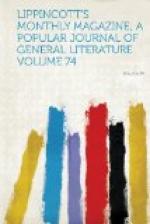became the property of Luke White, one of the most
remarkable men that Ireland has produced. In 1778,
Luke White was in the habit of buying cheap odds and
ends of literature from a bookseller, named Warren,
in Belfast to peddle about the country. In 1798
he loaned the Irish government, then in great difficulty,
a million of pounds! Mr. Warren, who found him
very punctual and exact, used to permit him to leave
his pack behind his counter and call for it in the
morning. No one would then have dreamed that
the greasy bag was to lead to such results. By
degrees, White scraped together some means. He
used to take odd volumes to a binder in Belfast and
employ him to get the “vol.” at the beginning
and end of an odd volume erased, so as to pass it off
among the unwary as a perfect book, and generally
furbish it up. Then he used to sell his literary
wares by auction in the streets of Belfast. The
knowledge he thus acquired of public sales procured
him a clerkship with a Dublin auctioneer. He
opened first a book-stall, and then a regular book-shop,
in Dawson street, a leading thoroughfare of Dublin.
There he became eminent. He sold lottery-tickets,
speculated in the funds and contracted for government
loans. In 1798, when the rebellion broke out,
the Irish government was desperately in need of funds.
They came into the Dublin market for a loan of a million,
and the best terms they could get were from Luke White,
who offered to take it at sixty-five pounds per one
hundred pound share at five per cent.—not
unremunerative terms.
At the time of his death, in 1824, he had long been
M.P. for Leitrim, and his son was member for the county
of Dublin. He left property worth a hundred and
seventy-five thousand dollars a year. Eventually
almost the whole of it devolved on his fourth son,
who some years ago was created a peer of the United
Kingdom as Lord Annaly.
The family has probably spent more than a million
and a half of dollars on elections. It has always
been on the Liberal side. The present peer has
property in about a dozen counties, and is lord-lieutenant
of Langford, whilst his younger son holds the same
high office in Clare.
The University of Dublin consists of a single college—Trinity.
This edifice forms a prominent feature in the Irish
metropolis. It stands in College Green, almost
opposite to the Bank of Ireland, the former legislative
chambers. Since the Union, Trinity College has
been but little resorted to by men of the upper ranks
of Irish society, although it has certainly contributed
some very eminent men to the public service—notably,
the late unfortunate governor-general, Lord Mayo, and
Lord Cairns, ex-lord-chancellor of England. Trinity
is one of the largest owners of real estate in the
country. The fellowships are far better than
those of the English universities. The provost,
who occupies a large and stately mansion, has a separate
estate worth some fifteen thousand dollars a year,
which he manages himself.




